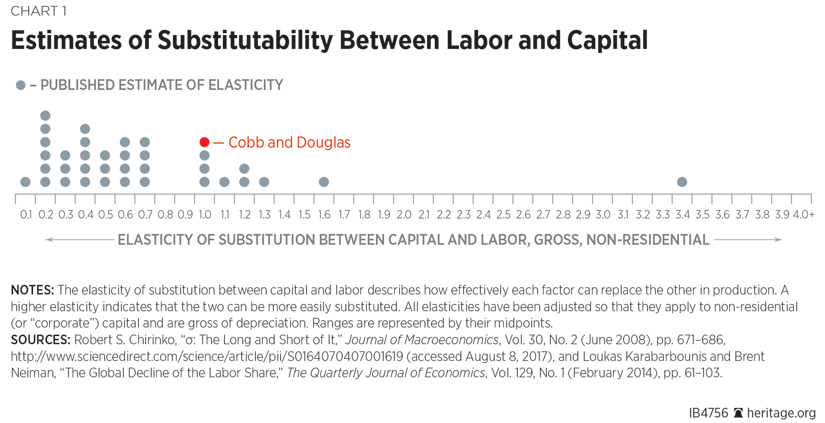Theory
In 1928, Charles Cobb and Paul Douglas published a brief article in the less-prestigious “Papers and Proceedings” supplement to the American Economic Review.[REF] They reviewed national economic data from 1899 to 1922 and proposed a simple (to economists, anyway) equation to explain the relationship between capital, labor, and production:
P’ = b Lk C1-k
They had discovered the economic equivalent of plastics. The Cobb–Douglas production function, as it became known, was a widely serviceable simplification of the massive, complex American economy. Over a century, the function has described an economy dominated first by farms, then by factories, and finally by the service sector. Economists—myself included—love it because it has simple predictions about wages, interest rates, and output.
Part of the beauty of the Cobb–Douglas production function is that it presents capital and labor as both complements and substitutes. In a Cobb–Douglas economy, capital and labor need each other, but can also fill in for each other. In economic jargon, the function exhibits “unit elasticity of substitution.”
Evidence
The real world, of course, is messier. For many applications, unit elasticity of substitution is an acceptable estimate. But more recent empirical work suggests that the long-run relationship between capital and labor is more complementary and less substitutable than Cobb and Douglas proposed. That is good news for anyone worried about robots: The data suggest humans are tough to replace.
A 2008 survey of dozens of empirical studies concluded that the elasticity of substitution is “in the range of 0.40–0.60”[REF]—about half the elasticity implied by Cobb and Douglas. Adding a more recent estimate to the 2008 survey, Chart 1 shows that there is substantial uncertainty, but the weight of the evidence is for an elasticity of substitution well below 1.

Meanwhile, U.S. investment has fallen behind. Since the Great Recession, private domestic investment has not exceeded 17 percent of gross domestic product (GDP), and investment actually fell between 2015 and 2016.[REF] Two economists at the Chicago Federal Reserve Bank estimated that capital per worker in the U.S. has fallen to 8 percent below its 1979–2014 trend.[REF]
Elasticity and You
Who cares? Well, it matters a great deal when considering how much policymakers should focus on restoring the low rate of business investment in the United States. The Cobb–Douglas model suggests that an 8 percent increase in capital per worker would increase wages by 8 percent. But the empirical research suggests an even stronger effect: An 8 percent increase in capital per worker would increase wages by between 13 percent and 20 percent.
Of course, this effect only works when capital investments are efficiently targeted. Government investment, predictably plumped for politically popular projects, will not have the same oomph.
Policymakers at all levels of government can, however, change the calculus for prospective investors.
- Congress should enact corporate tax reform with a focus on removing all disincentives to investment, which offers more potential wage growth than any other policy on offer.[REF]
- Congress should replace the Dodd–Frank Act with a light-touch financial regulatory system based on clearly written rules. Using a formal macroeconomic model, the Heritage Foundation recently estimated that removing the extra lending costs associated with Dodd–Frank would boost investment by 1.8 percent to 3.75 percent.[REF]
- State and local policymakers should set land-use rules that make investment much easier in low-regulation places than in high-regulation ones. Without new workplaces, it is difficult to create new jobs.
If policymakers pursue this pro-investment agenda, the real winners will not be investors, but American workers.
—Salim Furth, PhD, is Research Fellow in Macroeconomics in the Center for Data Analysis, of the Institute for Economic Freedom, at The Heritage Foundation.


